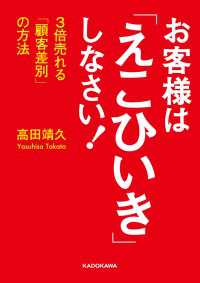Full Description
Focusing on the non-Western context and case studies, this book explores theories of interdisciplinary architectural thinking and the construction of urban memory in Chinese cities, with an emphasis on contemporary architecture and the diversity of agencies.
China has undergone one of the fastest urbanisation and urban renewal processes in human history, but discussions of urban memory in China have tended to be practice-oriented and lack theoretical reflection. This book brings together interdisciplinary architectural scholarship to interrogate the production of urban memory and examine experiences in China. The 14 chapters explore different processes, projects, materials, architecture and urban spaces in different Chinese cities by analysing cityscapes such as temples, bridges, conservation projects, architectural design, historical architecture, memorial hall, market street, city images, custom bike, food market and so on. The book deals with different agencies and methods, tangible and intangible, in the construction of memories aimed at promoting hybridised multiple identities, and explores the interplay of different versions of memory, i.e. state, public, regional, local, individual and collective memory.
This book will be essential reading for scholars and students of architecture and urbanism, cultural studies and China studies, as well as architects, urban planners and historians interested in these fields.
Contents
Introduction (by editors)
Part 1 Theories and Methods of Remembering
Chapter 1: Urban Memory by Heart: A Cultural Question
Xing Ruan
Chapter 2: Townscapes of Virtue: Urban Memory of Suzhou from Imperial China
Jing Xie
Chapter 3: Presencing Absence: History Memory Rewriting: Liu Kecheng's Interpretative Architecture
Laura Anna Pezzetti
Chapter 4: Memory, City, Language
Shiqiao Li
Part 2 Practices and Agencies of Remembering I: City-image and Urban Memory
Chapter 5: Remembering the Red Memories in Shanghai: Urban Memory Reconstructed for Shaping the Future of the City and the Nation
Yongyi Lu
Chapter 6: Exhibition, Institution, and the Urban Memory: The Shanghai Urban Planning Exhibition Centre and the Story of Making the City
Shih-Yao Lai
Chapter 7: Where the Dream Started: Branding Sea World and Shekou's Urban Memories in China
Fong Yi Khoo, Yat Ming Loo and Jonathan Hale
Part 3 Practices and Agencies of Remembering II: Architecture and Memory
Chapter 8: How Do We Forget Through Architecture?: A Case Study on the Reconstructed Jiming Monastery in Nanjing
Zhuge Jing and Chen Ting
Chapter 9: Decoding Urban Memory and Affect: Utopian and Anti-Utopian Narratives in Jiakun Liu's Novel and Architectural Works
Jiawen Han
Chapter 10: Invented Ruin, Concrete Memory: The Taizhou Contemporary Art Museum by Atelier Deshaus and the Shamen Grain Depot Cultural and Creative Park
Giaime Botti, Eugenio Mangi and Weixuan Chen
Part 4 Practices and Agencies of Remembering III: Everyday Life
Chapter 11: Subaltern Memories of the "Ghost" Street Market: Mapping the Vanishing Guishi in Tianjin
Yat Ming Loo and Yanning Xiang
Chapter 12: Revisiting Custom Bike Urbanism in China: An Opportunity to Revive Faded Urban Memories
Hiroyuki Shinohara
Chapter 13: From People's Park to Parks by the People
Jason Ho
Chapter 14: The Rise of "Individual Memories" in the Chinese City: The Refabrication of 29 Madao Street in Nanjing
Xiuxiu Li, Hua Li and Yipeng Wang








